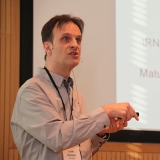
Max Perutz Labs (Division of Molecular Genetics)
Position: Professor
ORCID: 0000-0001-9152-7323
T +43 1 4277 61803
javier.martinez@meduniwien.ac.at
Keywords
Anemia, Diamond-Blackfan; Iron Metabolism Disorders; Oxidative Stress; RNA 3' End Processing; RNA processing
Research interests
RNA processing is an umbrella-term for a large number of chemical reactions that turn precursor RNAs into mature, functional molecules. At the core of our Lab is “Non-canonical RNA splicing”, a catalytic mechanism that removes single introns and joins remaining exons. Combining curiosity, expertise, networking and intuition, we keep digging into non-canonical RNA splicing and adventuring into new directions. Having identified several players of the enzymatic machinery executing non-canonical RNA splicing, we are currently focusing on regulatory and physiological aspects of it. We discovered that the tRNA ligase complex (tRNA-LC) is modulated by redox-mechanisms, involving metals, the antioxidant thioredoxin and the oxidoreductase PYROXD1, which protects the tRNA-LC against oxidation. We are also dissecting the individual roles of the tRNA-LC subunits. Our current research also shows that PYROXD1 plays a critical function in iron metabolism. We also discovered that RNA molecules ended in 2’,3’-cyclic phosphates, substrates of the tRNA-LC, are processed by the cyclic phosphatase ANGEL2, which is itself regulated by post-translational modifications. To end, we are making great progress in investigating Diamond Blackfan Anemia, a rare disease intimately linked to defects in RNA processing and iron metabolism. Please visit https://dbaexperiment.org.
Techniques, methods & infrastructure
biochemistry, molecular, cellular and structural biology, mouse models.
Selected publications
- Sekulovski, S. et al. (2021) ‘Assembly defects of human tRNA splicing endonuclease contribute to impaired pre-tRNA processing in pontocerebellar hypoplasia’, Nature Communications, 12(1). Available at: http://dx.doi.org/10.1038/s41467-021-25870-3.
- Asanović, I. et al. (2021) ‘The oxidoreductase PYROXD1 uses NAD(P)+ as an antioxidant to sustain tRNA ligase activity in pre-tRNA splicing and unfolded protein response’, Molecular Cell, 81(12), pp. 2520-2532.e16. Available at: http://dx.doi.org/10.1016/j.molcel.2021.04.007.
- Pinto, P.H. et al. (2020) ‘ANGEL2 is a member of the CCR4 family of deadenylases with 2′,3′-cyclic phosphatase activity’, Science, 369(6503), pp. 524–530. Available at: http://dx.doi.org/10.1126/science.aba9763.
- Hanada, T. et al. (2013) ‘CLP1 links tRNA metabolism to progressive motor-neuron loss’, Nature, 495(7442), pp. 474–480. Available at: http://dx.doi.org/10.1038/nature11923.
- Popow, J. et al. (2011) ‘HSPC117 Is the Essential Subunit of a Human tRNA Splicing Ligase Complex’, Science, 331(6018), pp. 760–764. Available at: http://dx.doi.org/10.1126/science.1197847.